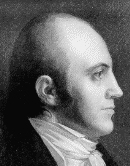
Aaron Burr was a central figure in American public life for nearly three decades, but is remembered mainly for two episodes in his life: his duel with Alexander Hamilton in 1804 and his schemes of empire-building that formed the basis for his 1807 treason trial.
Burr was born in Newark, New Jersey on February 6, 1756. Burr's parents died at an early age, leaving him in the care of an uncle who sometimes "beat him like a sack." Despite his hardships, Burr developed into an adventuresome and precocious child. At age 16, Burr graduated from Princeton. Three years later Burr joined Colonel Benedict Arnold's crusade against Quebec. His courage and success on the battlefield earned him a place on General Washington's staff.
In 1782, Burr stood for the bar in Albany and opened a law practice. That same year Burr married Theodosia Prevost, a woman ten years his senior with whom he would enjoy a close and loving relationship until her death in 1794. The other great love in Burr's life was his superbly talented daughter, also named Theodosia, born a year after the couple's marriage. (His hopes for Theosia's career, and insistence that she not be denied opportunities open to men, have led some historians to call Burr America's "first male feminist.")
By 1791, Burr had become a powerful political figure, having been elected United States Senator from New York. Burr's politics were marked by his liberal instincts and his expansionist dreams. In the election of 1800, Burr tied Thomas Jefferson in the electoral college. Burr became Vice President when the House of Representatives selected Jefferson as President in a contest that left the two men bitter enemies.
Burr's ambitions in conventional politics came to an end in 1804 when he was defeated in his bid for the governorship of New York. Burr blamed opposition leader Alexander Hamilton for his defeat, and challenged the famous Federalist to a duel. On July 11, 1804 in Weehawken, New Jersey, Burr mortally wounded Hamilton and was forced to flee New York and New Jersey when warrants were issued for his arrest.
After the duel, Burr's thoughts turned to the West. Historians disagree as to whether Burr's dealings with figures such as General James Wilkinson, former senator Jonathan Dayton and others constituted treason, or simply reflected the expansionist sentiments shared by many patriotic settlers west of the Alleghenies. If Burr's correspondence with the foreign ministers of Great Britain (Merry) and Spain (Yrujo) are taken at face value, Burr indeed was bent on securing a treasonous separation of the West from the Union, one that might have left him as the leader of a new western empire. On the other hand, it is possible that Burr's letters to the foreign ministers were only an attempt to capitalize on Great Britain's and Spain's hatred of the new American Republic, and to secure for himself the funds that would enable him to mount an expedition against the Spanish territory of Mexico. Whatever the precise nature of this scheme, it is clear that expansion and conquest were at its heart.
Burr's dreams, of course, went unrealized, and he became the defendant in an 1807 treason trial that is the focus of this website. Largely owing to a favorable interpretation of the law of treason by Chief Justice (and trial judge) John Marshall, Burr was acquitted. Nonetheless, the prosecution left Burr disgraced and facing constant harassment by creditors.
Burr lived out his later years in relative obscurity, dying in Staten Island, New York on September 14, 1836.
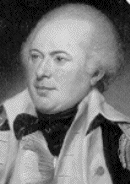
General James Wilkinson, commander of the Army of the United States, played a major role in the Burr Conspiracy, first as a co-conspirator and later as Burr's chief nemesis and the prosecution's chief hope for conviction.
The Conspiracy to attack Spanish territory and perhaps create a new nation west of the Alleghenies grew out of a series of conversations between Wilkinson and Vice President Burr during the winter of 1804-05. The design may have been more Wilkinson's than Burr's. Wilkinson knew the West as well as any man and sensed that many westerners were ready to move against the Spanish. Admiral Truxton quoted Burr as describing Wilkinson as "the projector" of the Conspiracy and as having said that he "would never have thought of such designs but for the importunities of Wilkinson."
By 1806, however, events convinced Wilkinson to abandon his plans. When on October 8, 1806, he received Burr's infamous ciphered letter, Wilkinson denounced Burr, alerted President Jefferson of Burr's plan to attack Mexico, and moved to crush Burr's troops. Wilkinson claimed ignorance of the entire enterprise and referred to Burr's followers as "bandits." He said it was "the highest ambition of my soul...to spend my last breath in the cause of my country."
Wilkinson send squads out to track down and arrest Burr. After Burr's arrest in February, 1807, Wilkinson ordered Burr transported by military guard to Washington (later the decision was made to take Burr to Richmond for trial).
After three months spent in New Orleans trying to line up witnesses to testify against Burr, Wilkinson arrived in Richmond on June 15, 1807, to meet his adversary and to find himself the subject of grand jury scrutiny. Wilkinson was dismayed, writing to a friend: "I had anticipated that a deluge of testimony would have poured forth from all quarters to overwhelm him [Burr] with guilt and dishonor. Sadly, indeed, I was mistaken, and to my astonishment I found the traitor vindicated and myself condemned by a mass of wealth, character, influence, and talents....Did I ever expect it would depend upon my humble self to stop the current of such a polluted stream? Never, never." Wilkinson ultimately escaped indictment for treason and misdemeanor on a 9 to 7 grand jury vote.
Wilkinson and Washington Irving, a courtroom eyewitness, offered differing account's of the first meeting of the general and Burr since Burr's arrest. Wilkinson wrote that upon seeing him, Burr "averted his face, grew pale, and affected passion to conceal his perturbation." Irving, on the other hand, said "Burr turned his head, looked him full in the face with one of his piercing regards, swept his eye over his whole person from head to foot, as if to scan his dimensions, then coolly resumed his former position."
Wilkinson (who never testified in the trial) remained a controversial figure throughout. Only Thomas Jefferson was unwavering in his support of the general. Prosecutor Hay reported, "My confidence in [Wilkinson] is shaken if not destroyed." John Randolph described Wilkinson as "the most finished scoundrel that ever lived." Historian Frederick Jackson Turner concurred in Randolph's judgment, calling Wilkinson "the most consummate artist of treason that the nation ever possessed."
After Burr's trial, Wilkinson was court-martialed in 1811 for being a pensioner of Spain while serving as general of the United States Army, but was acquitted. In 1812, Wilkinson commanded troops against the British in Canada, but met with defeat. He died in Texas in 1825.
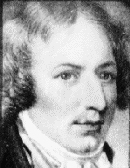
Harman Blennerhassett, with his wife and two children, lived on a three-mile long island in the Ohio River, "Blennerhassett's Island," that played a central role in the Burr Conspiracy and subsequent trial.
After emigrating to the United States from Ireland in 1796, Blennerhasset established himself on his island near Marietta, Ohio. A man of refined tastes, Blennerhassett succeeding in creating what was variously described as an "Eden" or an "enchanted isle." Guests at his luxurious mansion found musical instruments, an extensive library, well-kept grounds, and fine food.
In 1805, Burr (with perhaps no other person than inspecting the grounds) landed on the island and was invited to dinner by the Blennerhassetts. Over the course of a conversation that lasted until eleven o'clock in the evening, Burr shared with the Blennerhassets some of his ambitious plans.
On December 21, 1805, Blennerhasset replied to a Burr letter seeking his support in a military adventure in Spanish territory. Blennerhassett told Burr: "I should be honored in being associated with you, in any contemplated enterprise you would permit me to participate in....Viewing the probability of a rupture with Spain,...I am disposed, in the confidential spirit of this letter, to offer you and my friends' and my own services in any contemplated measures in which you may embark."
Within months, Blennerhassett was overseeing the production of boats and the obtaining of recruits and provisions for a possible military expedition involving Burr. Blennerhassett frankly told some of the recruits that the expedition would be heading to Mexico, and that a war with Spain was inevitable.
By late fall of 1806, state officials became aware of the conspiracy and took action. On December 7, four boats and about thirty men arrived on Blennerhassett's Island. Two days later, eleven of the remaining boats contracted for by Blennerhassett were seized by the militia. Hearing word of the seizure, hasty plans were made to leave the island, and late that night the party set off. The next day the militia arrived on the island, only to find that the quarry had left. They proceeded to ransack the mansion, raiding the cellar liquor store and destroying furniture.
Blennerhassett was finally seized by federal troops in Natchez, brought before a judge, and bound over for trial in Virginia. He was eventually released, only to be rearrested in Kentucky while en route to his island home. On June 24, 1807, Blennerhassett was indicted by a Richmond grand jury for treason and misdemeanor.
Blennerhassett sold his island in 1807. The mansion was destroyed by fire in 1811.
Blennerhasset practiced law for a period of time in Canada, then returned to England in 1822, and died on the Island of Guernsey.
Excerpt from William Wirt's Defense of Blennerhassett
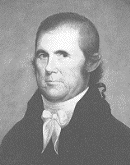
No person played a bigger role in the outcome of the Burr treason trial than did the Chief Justice of the United States, sitting in Richmond as trial judge, John Curtis Marshall. His narrow construction of the law of treason ended the prosecution's case and gave little room for the jury to do anything but find Burr "not guilty."
Marshall, the son of a close friend of George Washington, grew up in the Blue Ridge Mountains of Virginia. Marshall was an avid reader as a youth, memorizing passages from Pope's "Essay on Man" and other moral essays by the time he was twelve.
Marshall took law courses at William and Mary, then served in the Revolutionary War. In the 1780s, he became a member of both the Virginia bar and its state legislature. Marshall quickly emerged as a leader of Virginia Federalists, and began his long-time political rivalry with Thomas Jefferson, who emerged as the leader of the new Republican party.
President John Adams appointed Marshall Secretary of State in 1800, then in 1801, in one of his last acts as president, nominated Marshall to be the new Chief Justice of the United States. In 1803, Marshall would author the Court's decision in the famous case of Marbury v Madison, establishing the principle of judicial review.
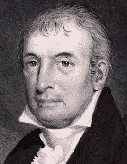
No lawyer in the Burr trial had a more distinguished record than defense attorney Luther Martin, called by Thomas Jefferson "the Bulldog of Federalism." Martin graduated from the College of New Jersey (later Princeton) in 1766, then moved to Maryland, where he would become an early advocated of independence. Martin became Maryland's attorney general in 1778.
In 1787, Martin represented Maryland at the Constitutional Convention in Philadelphia. He quickly established himself as one of the most influential delegates. He fought against slavery, for guaranteed civil rights and the rights of small states, and against a too-powerful federal government. Although his speeches were sometimes rambling, sarcastic, and dogmatic, out of session Martin had a reputation as being hearty, friendly, and jovial. After the Convention, Martin joined the unsuccessful fight against ratification.
Martin's legal practice grew to be as large as any in the young nation. In 1805, Martin was defense lawyer for Supreme Court Justice Samuel Chase in his Senate impeachment trial (presided over by Vice President Burr).
Martin played perhaps the leading role in Burr's defense in his 1807 treason trial at Richmond. He examined and cross-examined witnesses, and delivered the final defense argument in favor of the defense motion to arrest the prosecution's evidence. His arguments, as can be seen in the excerpt below, were delivered in florid style:
"When the sun mildly shines upon us, when the gentle zephyrs play around us, we can easily proceed forward in the straight path of our duty; but when bleak clouds enshroud the sky with darkness, when the tempest rages, the winds howl, and the waves break over us -- when the thunders awfully roar over our heads and the lightnings of heaven blaze around us -- it is then that all the energies of the human soul are called into action. It is then that the truly brave man stands firm at his post. It is then that, by an unshaken performance of his duty, man approaches the nearest possible to the Divinity. Nor is there any object in the creation on which the Supreme Being can look down with more delight and approbation than on a human being in such a situation and thus acting. May that God who now looks upon us, who has in his infinite wisdom called you into existence and placed you in that seat to dispense justice to your fellow citizens, to preserve and protect innocence against persecution -- may that God so illuminate your understandings that you may know what is rights; and may he heave your souls with firmness and fortitude to act according to that knowledge."
After the Burr trial, Martin was reappointed Attorney General in Maryland and argued before the U. S. Supreme Court Maryland's position in the landmark case of McCulloch v Maryland. Martin died in 1826, at the age of 78, in the New York City home of Aaron Burr.
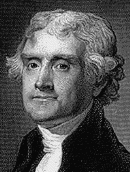
President Thomas Jefferson made the conviction of Aaron Burr his personal mission. In the end, he would blame his defeat on his old nemesis, Chief Justice John Marshall, whose rulings frustrated the prosecution at every turn. Jefferson complained in a letter written in September of 1807: "The scenes which have been acting at Richmond are sufficient to fill us with alarm. We supposed we possessed fixed laws to guard us equally against treason and oppression; but it now appears we have no law but the will of a judge."
Of course, Thomas Jefferson's reputation did not, unlike Aaron Burr's, stand to dramatically rise or fall on the outcome of the trial. The place of the author of the Declaration of Independence, founder of the University of Virginia, and third president of the United States was secure. It was in many ways one of Jefferson's most important acts as President, his entering into an agreement with France for the purchase of the western lands then called Louisiana, that set the stage for Burr's expansionist dreams that were the basis of his conspiracy.
Jefferson began to take a keen interest in Burr's western activities in late 1806. After receiving a letter from General Wilkinson detailing Burr's scheme, he signed a proclamation stating that "sundry persons...are conspiring...to...set on foot...a military expedition against the dominions of Spain." He urged all military and other government officials to devoted their attentions to "searching out and bringing to condign punishment all persons engaged or concerned in such enterprise." The president also sent west a confidential agent, a State Department clerk named Graham, to investigate the Burr plot.
Jefferson remained in close contact with George Hay and other prosecutors throughout the Burr trial, often offering advice as to strategy. When confronted with a subpoena demanding that he turn over to the defense certain letters in his possession, Jefferson refused. The matter was dropped.
After the trial, Jefferson talked about launching impeachment proceedings against Chief Justice Marshall, but it is doubtful that he ever gave the idea very serious consideration.
